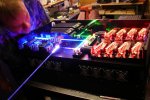Howell and his colleagues created a four-inch-long chamber filled with cesium gas heated to about 212 degrees Fahrenheit. When they sent pulses of laser light through that gas, the cesium atoms put the brakes on the leading edge of that wave, creating a photonic traffic jam.
"Essentially, the light just piles up," Howell said.
Once the slowed light exits, it naturally resumes it normal velocity -- 300 million meters per second, or fast enough to circle the Earth seven times in one second.
Most important, the peaks and troughs of Howell's light waves remained in phase as they stacked up, meaning they did not get out of step and cancel one another out. That is key, because phase is one aspect of light that carries information.
To prove that their slowed light did not get scrambled, the team sent their beam through a tiny stencil, less than one-fourth inch on each side, with the block letters "UR" -- the university's initials. Like a shadow-puppet image, that "UR"-shaped beam passed through the chamber, slowed and then emerged with its block letter message intact, as detected by a camera at the end.
Unlike most other systems for slowing light, this one worked at very low light levels. In one experiment, the "UR" image was clear even when a single photon -- the smallest possible quantity of light -- was beamed through the stencil.
The cesium-induced delays were brief, on the order of a few billionths of a second each. Looked at differently, each instance amounted to a two-foot long beam of light being compressed to less than four inches.
 by someone like arctos for example...
by someone like arctos for example...




